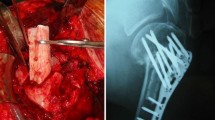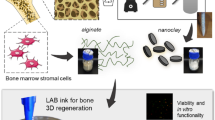Abstract
Introduction
Current therapeutic regimens in osteoarthritis (OA) address mainly pain but not the slow progressive degradation of the extracellular matrix (ECM) and the loss of a chondrogenic phenotype in articular cartilage. In the present study, using an early OA cancellous bone scaffold, we aimed to uncover evidence of the successful hyaline cartilage regenerative capacity of autologous human granulocyte colony-stimulating factor (hG-CSF)-activated peripheral blood stem cells (AAPBSC) with growth factor addition.
Materials and Methods
AAPBSC were harvested in ten patients (median age 58 years, 8 females), and flow cytometry was performed for cell surface markers. Arthroscopically obtained cancellous bone scaffold specimens were seeded with AAPBSC. In Group 1, the scaffold was seeded with AAPBSC only, in Group 2, AAPBSC plus hyaluronic acid (HA), and in Group 3, AAPBSC plus HA, hG-CSF, and double-centrifuged platelet-rich plasma (PRP). The specimens were analyzed for cell attachment and proliferation by the fluorometric quantification of cellular DNA assay and scanning electron microscopy. Chondrogenic gene expression was determined by reverse transcriptase-polymerase chain reaction (RT-PCR) of Sox9, collagen type II (COL-2), and aggrecan. Histological sections of scaffold constructs for cartilaginous matrix formation were stained with toluidine blue (proteoglycan) and safranin O (sGAG) after 3 weeks.
Results
AAPBSC displayed especially high levels of CD29 and CD44 surface markers, as well as CD90, and CD105, while only a small proportion expressed CD34. Almost half of the seeded cells attached on the bone scaffolds in all three groups (not statistically significant), whereas the means of cell proliferation on day 7 compared to day 1 were statistically significant difference with the order of increase as group 3 > group 2 > group 1. RT-PCR showed statistically significant sequential increases in Sox9, COL-2, and Aggrecan all being highest in group 3. Histological analysis demonstrated cells in the cancellous bone scaffold with a round morphology, and ECM was positively stained by toluidine blue and safranin O indicating increased proteoglycan and glycosaminoglycan content, respectively, in the newly formed cartilage matrix.
Conclusions
AAPBSC initiated chondrocyte differentiation on an autologous cancellous bone scaffold, and the addition of PRP and hG-CSF further stimulated cell proliferation toward a chondrocyte phenotype with potentiated Sox9 transcription resulting in sequential COL-2 and aggrecan mRNA increases that ultimately resulted in histologically confirmed increased proteoglycan and glucosaminoglycan content in newly formed hyaline cartilage.




Similar content being viewed by others
References
Akiyama H, Lefebvre V (2011) Unraveling the transcriptional regulatory machinery in chondrogenesis. J Bone Miner Metab 29:390–395. doi:10.1007/s00774-011-0273-9
Al Faqeh H, Nor Hamdan BM, Chen HC, Aminuddin BS, Ruszymah BH (2012) The potential of intra-articular injection of chondrogenic-induced bone marrow stem cells to retard the progression of osteoarthritis in a sheep model. Exp Gerontol 47:458–464. doi:10.1016/j.exger.2012.03.018
Buda R, Vannini F, Cavallo M, Baldassarri M, Luciani D, Mazzotti A, Pungetti C, Olivieri A, Giannini S (2013) One-step arthroscopic technique for the treatment of osteochondral lesions of the knee with bone-marrow-derived cells: three years results. Musculoskelet Surg 97:145–151. doi:10.1007/s12306-013-0242-7
Chiba Y, Kuroda S, Osanai T, Shichinohe H, Houkin K, Iwasaki Y (2012) Impact of ageing on biological features of bone marrow stromal cells (BMSC) in cell transplantation therapy for CNS disorders: functional enhancement by granulocyte-colony stimulating factor (G-CSF). Neuropathology 32:139–148. doi:10.1111/j.1440-1789.2011.01255.x
Duff SE, Li C, Garland JM, Kumar S (2003) CD105 is important for angiogenesis: evidence and potential applications. FASEB J 17:984–992. doi:10.1096/fj.02-0634rev
Emadedin M, Aghdami N, Taghiyar L, Fazeli R, Moghadasali R, Jahangir S, Farjad R et al (2012) Intra-articular injection of autologous mesenchymal stem cells in six patients with knee osteoarthritis. Arch Iran Med 15:422–428. doi:http://www.ncbi.nlm.nih.gov/pubmed/22724879
Furumatsu T, Asahara H (2010) Histone acetylation influences the activity of Sox9-related transcriptional complex. Acta Med Okayama 64: 351–357. http://www.lib.okayama-u.ac.jp/www/acta/pdf/64_6_351.pdf
Grimsholm O, Guo Y, Ny T, Forsgren S (2008) Expression patterns of neurotrophins and neurotrophin receptors in articular chondrocytes and inflammatory infiltrates in knee joint arthritis. Cells Tissues Organs 188:299–309. doi:10.1159/000121432
Huang CY, Reuben PM, D’Ippolito G, Schiller PC, Cheung HS (2004) Chondrogenesis of human bone marrow-derived mesenchymal stem cells in agarose culture. Anat Rec A Discov Mol Cell Evol Biol 278:428–436. doi:10.1002/ar.a.20010
Kiani C, Chen L, Wu YJ, Yee AJ, Yang BB (2002) Structure and function of aggrecan. Cell Res 12:19–32. doi:10.1038/sj.cr.7290106
Li N, Yuan R, Chen T, Chen L, Jin X (2009) Effect of platelet-rich plasma and latissimus dorsi muscle flap on osteogenesis and vascularization of tissue-engineered bone in dog. J Oral Maxillofac Surg 67:1850–1858. doi:10.1016/j.joms.2009.04.029
Maes C, Araldi E, Haigh K, Khatri R, Van Looveren R, Giaccia AJ, Haigh JJ, Carmeliet G, Schipani E (2012) VEGF-independent cell-autonomous functions of HIF-1α regulating oxygen consumption in fetal cartilage are critical for chondrocyte survival. J Bone Miner Res 27:596–609. doi:10.1002/jbmr.1487
Mishra A, Tummala P, King A, Lee B, Kraus M, Tse V, Jacobs CR (2009) Buffered platelet-rich plasma enhances mesenchymal stem cell proliferation and chondrogenic differentiation. Tissue Eng Part C Methods 15:431–435. doi:10.1089/ten.tec2008.0534
Ogawa M, LaRue AC, Mehrotra M (2013) Hematopoietic stem cells are pluripotent and not just “hematopoietic”. Blood Cells Mol Dis 51:3–8. doi:10.1016/j.bcmd.2013.01.008
Parsons P, Hesselden K, Butcher A, Maughan J, Milner R, Horner A (2009) The biological effect of platelet rich-plasma on the fracture healing process. J Bone Joint Surg Br 91B (Suppl 2): 293-c. doi:10.1097/BOT.0b013e318188dbb7
Quintero M, Riera H, Colantuoni G, Khatib AM, Attalah H, Moldovan F, Mitrovic DR, Lomri A (2008) Granulocyte-macrophage colony stimulating factor is anabolic and interleukin-1beta is catabolic for rat articular chondrocytes. Cytokine 44:366–372. doi:10.1016/j.cyto.2008.10.003
Sasaki K, Kuroda R, Ishida K, Kubo S, Matsumoto T, Mifune Y, Kinoshita K, Tei K, Akisue T, Tabata Y, Kurosaka M (2008) Enhancement of tendon-bone osteointegration of anterior cruciate ligament graft using granulocyte colony-stimulating factor. Am J Sports Med 36:1519–1527. doi:10.1177/0363546508316282
Saw KY, Anz A, Merican S, Tay YG, Ragavanaidu K, Jee CS, McGuire DA (2011) Articular cartilage regeneration with autologous peripheral blood progenitor cells and hyaluronic acid after arthroscopic subchondral drilling: a report of 5 cases with histology. Arthroscopy 27:493–506. doi:10.1016/j.arthro.2010.11.054
Saw KY, Anz A, Siew-Yoke Jee C, Merican S, Ching-Soong Ng R, Roohi SA, Ragavanaidu K (2013) Articular cartilage regeneration with autologous peripheral blood stem cells versus hyaluronic acid: a randomized controlled trial. Arthroscopy 29:684–694. doi:10.1016/j.arthro.2012.12.008
Saw KY, Hussin P, Loke SC, Azam M, Chen HC, Tay YG, Low S, Wallin KL, Ragavanaidu K (2009) Articular cartilage regeneration with autologous marrow aspirate and hyaluronic Acid: an experimental study in a goat model. Arthroscopy 25:1391–1400. doi:10.1016/j.arthro.2009.07.011
Scott RD (2006) Three decades of experience with unicompartmental knee arthroplasty: mistakes made and lessons learned. Orthopedics 29:829–831. http://www.healio.com/orthopedics/journals/ortho/%7Bef614288-91c9-468b-b49f-20fd0bdcc4b8%7D/three-decades-of-experience-with-unicompartmental-knee-arthroplasty-mistakes-made-and-lessons-learned?fulltext=1
Singh JA (2012) Stem cells and other innovative intra-articular therapies for osteoarthritis: what does the future hold? BMC Med 10:44. doi:10.1186/1741-7015-10-44
Takahashi Y, Yamamoto M, Tabata Y (2005) Osteogenic differentiation of mesenchymal stem cells in biodegradable sponges composed of gelatin and β-tricalcium phosphate. Biomaterials 26: 3587–3596. doi:10.1016/j.biomaterials.2004.09.046
Turajane T, Chaveewanakorn U, Larbpiboonpong V, Aojanepong J, Thitiset T, Honsawek S, Fongsarun J, Papadopoulos KI (2013) Combination of intraarticular autologous activated peripheral blood stem cells with growth factor addition/preservation and hyaluronic acid in conjunction with arthroscopic microdrilling mesenchymal cell stimulation improves quality of life and regenerates articular cartilage in early osteoarthritic knee disease. J Med Assoc Thai 96:580–588
Wan R, Hu J, Zhou Q, Wang J, Liu P, Wei Y (2012) Application of co-expressed genes to articular cartilage: new hope for the treatment of osteoarthritis (Review). Mol Med Report 6:16–18. doi:10.3892/mmr.2012.859
Wang S, Qu X, Zhao RC (2012) Clinical applications of mesenchymal stem cells. J Hematol Oncol 5:19. doi:10.1186/1756-8722-5-19
Wu W, Chen F, Liu Y, Ma Q, Mao T (2007) Autologous injectable tissue-engineered cartilage by using platelet-rich plasma: experimental study in a rabbit model. J Oral Maxillofac Surg 65:1951–1957. doi:10.1016/j.joms.2006.11.044
Acknowledgments
The authors would like to thank the Research Core Facility of the Department of Biochemistry and Chulalongkorn Medical Research Center (ChulaMRC) for kindly providing facilities; Dusit Vejchakan Foundation, Surgeon in Chief Foundation, Police General Hospital, TRB Chermidica Co., Ltd.; Dr. Juthatip Fongsarun for performing the leukaphereses and all patients and their families for participating in the study.
Conflict of interest
THAI StemLife Co., Ltd. has financially supported the autologous leukaphereses in the 10 samples tested. KP holds shares in THAI StemLife’s founding company and is an executive board member of THAI StemLife. The remaining authors have no competing financial or non-financial interests.
Author information
Authors and Affiliations
Corresponding author
Rights and permissions
About this article
Cite this article
Turajane, T., Thitiset, T., Honsawek, S. et al. Assessment of chondrogenic differentiation potential of autologous activated peripheral blood stem cells on human early osteoarthritic cancellous tibial bone scaffold. Musculoskelet Surg 98, 35–43 (2014). https://doi.org/10.1007/s12306-013-0303-y
Received:
Accepted:
Published:
Issue Date:
DOI: https://doi.org/10.1007/s12306-013-0303-y




